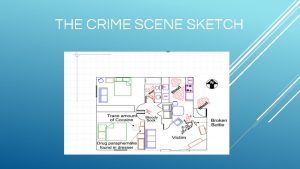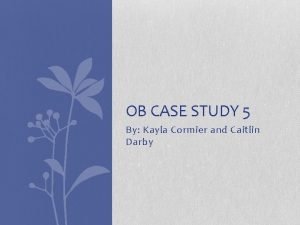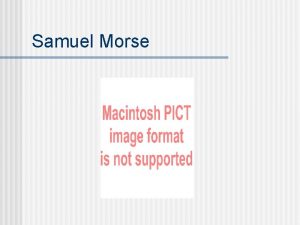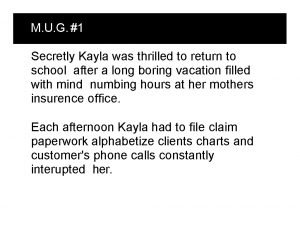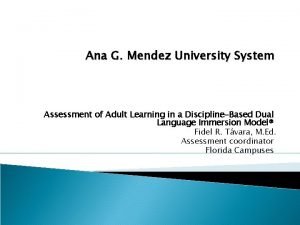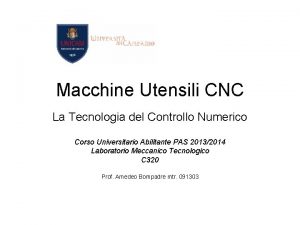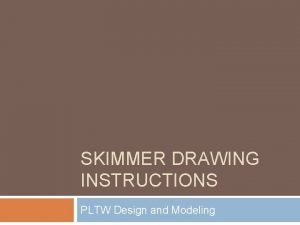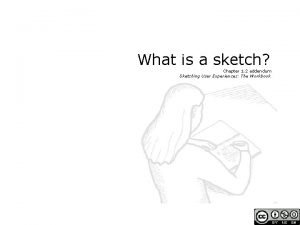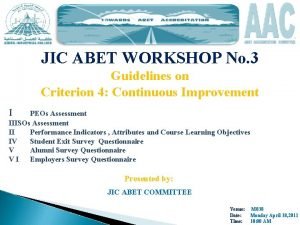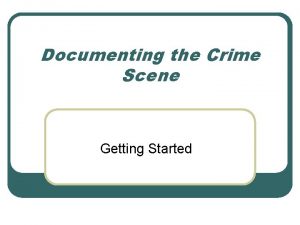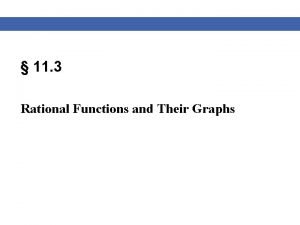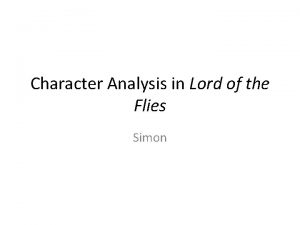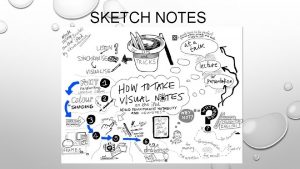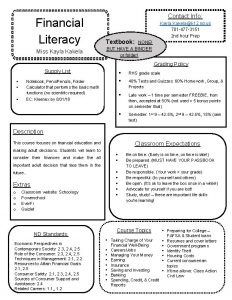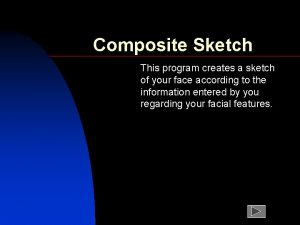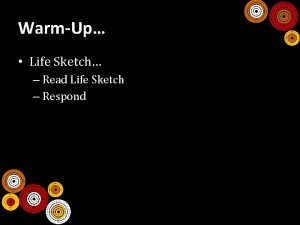Zero MQofi sketch Kayla Seager Purpose of discussion










































- Slides: 42

Zero. MQ-ofi sketch Kayla Seager

Purpose of discussion 1. Explore requirements of Zero. MQ (“sockets library”) – Zero. MQ: widely used in AI/enterprise 2. Identify Mismatches between Zero. MQ and Libfabric – Focus on a commonly used subset of ZMQ API 3. Brainstorm Libfabric improvements 2

Zeromq “Asynchronous sockets library with load balancing” 3

What is Zero. MQ? Socket-like interface but builds features on top of it… 1. Multiple Connections per socket 2. Async communication model: fire and forget 3. Background CM: listen/accept 4. Message-based (vs stream) 5. Some built-in load balancing (defined by socket type) 4

ZMQ Objects & Mapping to OFI ZMQ CTX ZMQ Socket fd Connection fd FI_DOMAIN ZMQ Socket fd Connection fd FI_EP Connection fd

Example Code 1) void *context = zmq_ctx() Server: Client: 2) void *rep_sock = 2) void *req_sock = zmq_socket(context, ZMQ_REP) zmq_socket(context, ZMQ_REQ) 3) zmq_bind(rep_sock, “tcp: //*: 4040”) 3) zmq_connect(req_sock, “tcp: //localhost: 4040”) 4) zmq_recv(rep_sock, buffer, 6, flag) 4) zmq_send(req_sock, “hello”, 6, flag) 6

Example Code: What’s missing? Server: Client: No destination address provided! 4 zmq_recv(rep_sock, buffer, 6, flag) zmq_send(req_sock, “hello”, 6, flag) One socket <--> multiple connections how does it pick the connection? 7

Example Code: Server: Client: zmq_socket(context, ZMQ_REP) zmq_socket(context, ZMQ_REQ) Socket type determines connection selection Learning curve… 8

Socket types/Message Patterns Definition: how and when to use connections Example: § Request-Reply: (ZMQ_REQ/ZMQ_REP) Load balancing – Dealer/Router § Pub-Sub: broadcast to all connections § Exclusive Pair: only one connection Different sockets with the right type can connect to each other

REQ/REP: synchronous Send/Recv • Requires a single REQ and REP socket • Synchronous send/recv • Will wait for recv from socket it sent to • Round Robin load balancing 1 Wait for Sock. A recv sg 1 nd(m se REQ. ) Sock REQ ) Sock. A REP RE Q. se 2 nd (m sg 2 Sock. B REP

Round Robin Send send one message to each destination in round robin order send msg 1 send msg 2 2 1 dest 1 send msg 3 dest 2 dest 3 dest 1 dest 2 dest 3 11

Fair Queue Recv Read one message from each destination in round robin order Recv(msg 1, dest 1) Recv(msg 2, dest 2) Recv(msg 3, dest 3) 1 2 3 Msg. Q Dest 1 Msg. Q Dest 2 Msg. Q Dest 3 12

Dealer/Router • Aynchronous (REP/REQ) • Round Robin load balancing • send and receive! • Router: uses ID for connections

Special case: Router and IDs Wait you can set the Destination? (on Router Send only) Dealer/Client: (connection to Router) • • Can “address” your connection via ID’s can set ID (else ZMQ will set one for you) Router and ID management: • • Specify Send via connection ID • Expects first “message” to be ID • uses it for connection look-up Receive • Round robins connections • Chosen connection: look-up which ID, • First receive is ID, then message

Special case: Router and IDs Client: set ID zmq_setsockopt( client_sock, ZMQ_IDENTITY, Client. A_ID…) zmq_connect( client_sock, Router_address ) 3) zmq_recv(msg_for_Client. A) 4) zmq_send(msg_for_Router) Router Server: 1) zmq_send(Client. A_ID, MORE) 2) zmq_send(msg_for_Client. A) 5) zmq_recv(Client. A_ID) 6) zmq_recv(msg_for_Router) ID is only used at Router Socket layer – not transmitted

ZMQ Architecture: Single Socket Front End: • Front end Message Pattern Protocol implementation • ZMQ_REP/REQ… • Put/recv message on/from queue • Signal backend User’s ZMQ socket_fd Control messaging Message Queue • Back end • “fi_send/fi_recv” • Put/recv message on/from queue • Signal front end • CM polling Back End: Transport/CM Poll(fds. . ) network “Pipes” created per connection

Overall ZMQ goal: build systems Make asynchronous sockets “easy” ZMQ sockets are “lego blocks” for messaging systems Not constrained to any particular system can do broker or brokerless 17

Case Study: MXNet-Pslite Model: • AI Framework • ZMQ API usage • Router/Dealer socket type Dealer Dealer Dealer process 1 process 2 process 3 Router bind • Msg API (send/recv) • MORE flag connect Dealer Node 4 Router 18

Zero. MQ – OFI mismatches 19

Related Work note • Alice – Fair. MQ - Nanomsg • Nanomsg: • refactored Zero. MQ • Pluggable transports • Nanomsg-Libfabric (us. NIC target) • PR for true Zero-Copy support • Can’t reuse existing FD based solns 20

User’s ZMQ socket_fd ZMQ Architecture Front End: Not a great fit for Libfabric We already have async communication… • Asynchronous progress Message Pattern Protocol implementation Control messaging Message Queue • Message queues Back End: Transport/CM Are we only missing the message patterns? no…. Poll(fds. . ) network “Pipes” created per connection

ZMQ Semantic mismatches for Libfabric 1. Multi-connection “endpoints” 2. Dynamic Process management 3. Buffered receive 4. Peer-to-peer flow control 5. Shared memory solution

1. Multi-connection “endpoints” One endpoint: multiple connect oriented connections? mapping to connectionless FI_EP_RDM or single connection FI_EP_MSG? It is multi-connection per socket…

2. Dynamic Process management Back End: Transport/CM Poll(fds. . ) network

CM Problem statement 1 Need Server/Client name Exchange - Can’t solely use ZMQ “CM” calls - Need to be able to go from a bind->send Creating and destroying connections at any time Can’t have CM send/recv interfere with messaging – Need a dedicated separate CM channel – Can’t have a recv(any) interfering with the routing/scheduling algorithm

CM Problem statement 2 Utility CM: -need timeout if client tries to resolve server address before server is started

3. Buffered receive ZMQ Buffering Requirement -forces buffer to come from transport Zmq_msg_t msg create_buffer()

ZMQ Buffering Requirement 1. ZMQ_MSG_API § Requires usage of zmq_msg_t (internal to transport buffer) – User responsible for create/destroy 2. MORE flag § send/recv API has “MORE” flag capability – Multiple send/recv treat as send/recv single message 28

ZMQ Buffer: ZMQ_MSG API • zmq_msg_t: buffer “handle” • Asks ZMQ to provide buffer – But user decides on lifetime of ptr (malloc/free) Example: Send

ZMQ Buffer: ZMQ_MSG API Example: Recv 1. Void * context = Zmq_ctx() 2. Void * rep_sock = Zmq_socket(context, ZMQ_REP) 3. Zmq_bind(rep_sock, “tcp: //*: 4040”) 4. Zmq_msg_t msg 5. Zmq_msg_init(msg) 6. Zmq_msg_recv(&rep_sock, msg, flag) , Asked ZMQ to buffer without knowing size

ZMQ Buffer: MORE flag cont. • Transport implications: multi-msg as “one message” • must have local completion of segments • Must buffer “iovec” segments • User API: Parts are sent separately and received separately • Must receive all or none of the message parts buf 1 Zmq_recv(buf 1, MORE) buf 2 buf 3 Zmq_recv(buf 2, MORE) Zmq_recv(buf 3, 0) 31

ZMQ Buffer: MORE flag treat as single fi_send ZMQ tells user if there is more to receive 32

ZMQ Buffer: Summary • Need buffering for zmq_msg_t handle • receive side: user won’t provide • Length • Buffer • Libfabric Options • FI_PEEK helps, but no buffer support • Buffered send/recv iovec? • “buffered” recv? 33

4. Peer-to-peer flow control Implementing Router/Dealer socket type: ->Requirement comes out of load balancing support 1 2 3 Msg. Q Dest 1 Msg. Q Dest 2 Msg. Q Dest 3 34

Router Requirements: ID & FQ 1. ID management § Create ID’s for sockets (sockopt) § Map to connections 2. Send/Recv § Send: – ID lookup § Receive: – Fair queuing – Return ID 35

Router Requirements: flow control Loop over active connections in Round Robin fashion If queue is either empty or full (unused or overused), deactivate – Atomic swap into deactivated index – – reactivated by backend High water mark: relies on TCP flow control – (full queue) Round Robin: Message in queue? Connection 1 Msg. Q Connection 2 Msg. Q Logical End of active connections Connection 3 Msg. Q Connection 4 Msg. Q 36

5. shared memory solution: Extent of Zero. MQ transport support TCP IPC (inter-process communication) TIPC Cluster IPC with socket interface INPROC Inter-thread communication EPGM NORM EPGM? PGM Norm Engines Stream Engine Shared Memory Unicast (can do all protocols) Multicast (only PUB/SUB)

Summary ZMQ mismatches for Libfabric 1. Multi-connection “endpoints” 2. Dynamic Process management 3. Buffered receive 4. Peer-to-peer flow control 5. Shared memory solution

Thank you! 39

Case Study: AI Framework MXNet-Pslite Model: • Per process resources Dealer Dealer Dealer process 1 process 2 process 3 Router bind • N x Dealer sockets • Send only • 1 Router socket • Recv only • Dealers connect to one Router • Dedicated connection • Router receive connect Dealer Node 4 Router • Fair queuing all incoming recvs 40

How does it compare to other MQ systems? Pro: • Brokerless • higher throughput/latency • More flexible in message model options • Messaging library Con: • Static routing (always RR) • Learning curve • Harder to build complex systems 41

 Finish sketch crime scene
Finish sketch crime scene Crime scene sketch
Crime scene sketch Rough sketch vs final sketch crime scene
Rough sketch vs final sketch crime scene Fractional distillation
Fractional distillation Fatinah albeez
Fatinah albeez Cloud 9 kayla morgan
Cloud 9 kayla morgan As kayla was introduced
As kayla was introduced Kayla pietz
Kayla pietz Kayla franco
Kayla franco Ob case study
Ob case study Kayla turner periodista
Kayla turner periodista Kayla tomlin
Kayla tomlin Samuel morse background
Samuel morse background M.u.g. #12 answers
M.u.g. #12 answers Kayla oxley
Kayla oxley Although i raised marcee and obbie from puppies
Although i raised marcee and obbie from puppies Trans kayla mendez
Trans kayla mendez Where is taiga located on the map
Where is taiga located on the map Kayla byrd
Kayla byrd Introduction to energy management
Introduction to energy management Genetically modified crops
Genetically modified crops Flannery mullins
Flannery mullins Chimney sweep stuck
Chimney sweep stuck Ivana mari
Ivana mari Zero macchina cnc
Zero macchina cnc Zero defect zero effect
Zero defect zero effect Purpose of discussion
Purpose of discussion Draft for discussion purpose only
Draft for discussion purpose only Chapter 5 selecting a topic and a purpose
Chapter 5 selecting a topic and a purpose Complex sentence purpose
Complex sentence purpose Proscenium theatre diagram
Proscenium theatre diagram Albert einstein character sketch
Albert einstein character sketch Skimmer sketch
Skimmer sketch Sketch chapter 1
Sketch chapter 1 Adding this dimension will overconstrain the sketch
Adding this dimension will overconstrain the sketch Firmer chisel diagram
Firmer chisel diagram Problem statement sketch
Problem statement sketch Sketch all serious crime and crash scenes:
Sketch all serious crime and crash scenes: Sketch the graph of the following rational function
Sketch the graph of the following rational function Simon character traits
Simon character traits Shared core practice model
Shared core practice model Thor character development
Thor character development The terms grid linear quadrant zone and spiral
The terms grid linear quadrant zone and spiral

